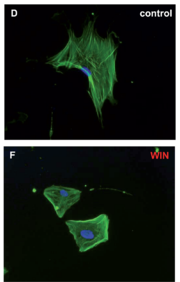
WIN 55,212-2
Encyclopedia
WIN 55,212-2 is a chemical described as an aminoalkylindole derivative, that produces effects similar to those of cannabinoid derivatives such as THC
but has an entirely different chemical structure
.
WIN 55,212-2 is a potent cannabinoid receptor agonist which has been found to be a potent analgesic in a rat model of neuropathic pain. It activates p42 and p44 MAP kinase via receptor-mediated signaling.
WIN 55,212-2, alongside HU-210
and JWH-133
, are implicated in preventing the inflammation caused by Amyloid beta
proteins involved in Alzheimer's Disease
, in addition to preventing cognitive impairment and loss of neuronal markers. This anti-inflammatory action is induced through the agonization of cannabinoid receptor
s which prevents microglia
l activation that elicits the inflammation. Additionally, cannabinoids completely abolish neurotoxicity related to microglia activation in rat models.
WIN 55,212-2 is a full agonist at CB1 (Ki
= 1.9nM) and has much higher affinity than THC
(Ki = 41nM) for the CB1 receptor..

Tetrahydrocannabinol
Tetrahydrocannabinol , also known as delta-9-tetrahydrocannabinol , Δ1-THC , or dronabinol, is the main chemical psychoactive substance found in the cannabis plant. It was first isolated in 1964. In pure form, it is a glassy solid when cold, and becomes viscous and sticky if warmed...
but has an entirely different chemical structure
Chemical structure
A chemical structure includes molecular geometry, electronic structure and crystal structure of molecules. Molecular geometry refers to the spatial arrangement of atoms in a molecule and the chemical bonds that hold the atoms together. Molecular geometry can range from the very simple, such as...
.
WIN 55,212-2 is a potent cannabinoid receptor agonist which has been found to be a potent analgesic in a rat model of neuropathic pain. It activates p42 and p44 MAP kinase via receptor-mediated signaling.
WIN 55,212-2, alongside HU-210
HU-210
HU-210 is a synthetic cannabinoid that was first synthesized in 1988 from -Myrtenol by the group led by Professor Raphael Mechoulam at the Hebrew University. HU-210 is 100 to 800 times more potent than natural THC from cannabis and has an extended duration of action...
and JWH-133
JWH-133
JWH-133 is a potent selective CB2 receptor agonist, with a Ki of 3.4nM and selectivity of around 200x for CB2 over CB1 receptors. It was discovered by, and named after, John W...
, are implicated in preventing the inflammation caused by Amyloid beta
Amyloid beta
Amyloid beta is a peptide of 36–43 amino acids that is processed from the Amyloid precursor protein. While it is most commonly known in association with Alzheimer's disease, it does not exist specifically to cause disease...
proteins involved in Alzheimer's Disease
Alzheimer's disease
Alzheimer's disease also known in medical literature as Alzheimer disease is the most common form of dementia. There is no cure for the disease, which worsens as it progresses, and eventually leads to death...
, in addition to preventing cognitive impairment and loss of neuronal markers. This anti-inflammatory action is induced through the agonization of cannabinoid receptor
Cannabinoid receptor
The cannabinoid receptors are a class of cell membrane receptors under the G protein-coupled receptor superfamily. As is typical of G protein-coupled receptors, the cannabinoid receptors contain seven transmembrane spanning domains...
s which prevents microglia
Microglia
Microglia are a type of glial cell that are the resident macrophages of the brain and spinal cord, and thus act as the first and main form of active immune defense in the central nervous system . Microglia constitute 20% of the total glial cell population within the brain...
l activation that elicits the inflammation. Additionally, cannabinoids completely abolish neurotoxicity related to microglia activation in rat models.
WIN 55,212-2 is a full agonist at CB1 (Ki
Dissociation constant
In chemistry, biochemistry, and pharmacology, a dissociation constant is a specific type of equilibrium constant that measures the propensity of a larger object to separate reversibly into smaller components, as when a complex falls apart into its component molecules, or when a salt splits up into...
= 1.9nM) and has much higher affinity than THC
Tetrahydrocannabinol
Tetrahydrocannabinol , also known as delta-9-tetrahydrocannabinol , Δ1-THC , or dronabinol, is the main chemical psychoactive substance found in the cannabis plant. It was first isolated in 1964. In pure form, it is a glassy solid when cold, and becomes viscous and sticky if warmed...
(Ki = 41nM) for the CB1 receptor..

External links
- Biomol Win 55,212-2 Data Sheet
- The cannabinoid WIN 55,212-2 inhibits transient receptor potential vanilloid 1 (TRPV1TRPV1The transient receptor potential cation channel subfamily V member 1 ', also known as the capsaicin receptor and the vanilloid receptor 1, is a protein that, in humans, is encoded by the TRPV1 gene...
) and evokes peripheral antihyperalgesia via calcineurinCalcineurinCalcineurin is a protein phosphatase also known as protein phosphatase 3, PPP3CA, and calcium-dependent serine-threonine phosphatase, and formerly known as protein phosphatase 2B . It activates the T cells of the immune system and can be blocked by drugs...
. 2006 Jul 18; - JNeurosci.org Prevention of Alzheimer's Disease Pathology by Cannabinoids: Neuroprotection Mediated by Blockade of Microglial Activation
- New Scientist: Hope for cannabis-based drug for Alzheimer's

